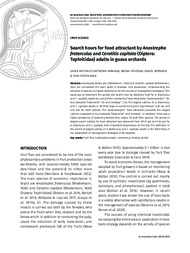Search hours for food attractant by Anastrepha fraterculus and Ceratitis capitata (Diptera: Tephritidae) adults in guava orchards.
Search hours for food attractant by Anastrepha fraterculus and Ceratitis capitata (Diptera: Tephritidae) adults in guava orchards.
Author(s): CONTRERAS-MIRANDA, J. A.; PIOVESAN, B.; BERNARDI, D.; NAVA, D. E.
Summary: Anastrepha fraterculus (Wiedemann, 1830) and Ceratitis capitata (Wiedemann, 1824) are considered the main pests of Brazilian fruit production. Understanding the behavior of species is of great importance for the success of management strategies. This study was to determine the period and search time by attractive food for A. fraterculus and C. capitata adults by using three commercial food attractants: BioAnastrepha™ 5%; Isca Samaritá Tradicional™ 5% and Ceratrap™ 1.5%. The largest catches of A. fraterculus and C. capitata adults in McPhail traps occurred during the day between 6:30 am and 6:30 pm for both species. The BioAnastrepha™ food attractant provided the largest catches compared to Isca Samaritá Tradicional™ and Ceratrap™. In addition, there was a higher prevalence of capturing females than males, for both flies’ species. The period of largest search activity for food attractant was observed from 12h:31 pm to 04:30 pm for A. fraterculus and C. capitata, time of greatest temperature on the day. The definition of the period of largest activity of A. fraterculus and C. capitata adults in the field helps in the elaboration of management strategies to be adopted.
Publication year: 2023
Types of publication: Journal article
Keywords: Anastrepha, Anastrepha Fraterculus, Fruticultura
Observation
Some of Embrapa's publications are published as ePub files. To read them, use or download one of the following free software options to your computer or mobile device. Android: Google Play Books; IOS: iBooks; Windows and Linux: Calibre.
Access other publications
Access the Agricultural Research Database (BDPA) to consult Embrapa's full library collection and records.
Visit Embrapa Bookstore to purchase books and other publications sold by Embrapa.

